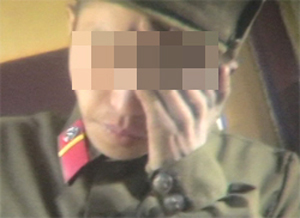A Soldier’s Last Journey
 The Japanese NGO RENK, which has scored some incredibly brave video “gets” from inside North Korea, has done it again. They smuggled a videocamera onto a North Korean train and surreptitiously interviewed a North Korean soldier who was being send home to “recover” from malnutrition. Daily NK has the report, with pictures and a partial interview transcript.
The Japanese NGO RENK, which has scored some incredibly brave video “gets” from inside North Korea, has done it again. They smuggled a videocamera onto a North Korean train and surreptitiously interviewed a North Korean soldier who was being send home to “recover” from malnutrition. Daily NK has the report, with pictures and a partial interview transcript.
Rank of the soldier Kim Man Chul interviewed is the lowest one. The North Korean trains have separate cart for civilian passengers and the military and while the military can aboard whichever cart they desire to, the civilians can only travel on the civilian cart. The interview was possible because there were not more sits left in the military cart and the soldier rode on the civilian cart.
He was a soldier who was suffering from malnutrition, who was ordered to return home for a certain period of time to recover. Currently it has been known that many soldiers have been returning home for malnutrition. The interviewee was at the age of 19 and from Kangkye of Jakang province. He said he had been interned at a hospital for 2-3 years since he joined the military, but because he could not receive adequate treatment (nutrition) he is returning to home where his sister is for his recovery.
When our interviewer asks, “Have you eaten?” the low rank soldier answers, “Even if I did eat, I cannot digest. My intestines do not work. Mere exchange of few words reveal how serious the malnutrition the low rank North Korean soldiers may be suffering.
Furthermore, the soldier tells about the good situation inside the military, “In the compound we do not even have pickled food, and when we have salt, we put it in our pocket to eat alone.
Then by telling the interview that after his recovery he would rather not return to the military, we discover that the soldier’s remarks proves the experts analysis on the weakening of the morale in the North Korean military from the lower ranks.
Why can’t a 19 year-old digest? Most likely the culprit is “alternative foods” that the North Korean government is producing. They’re made in part from sawdust, corn cobs, tree bark, and wild grasses. They fill the stomach, but they have little nutritional value and are nearly indigestable. Another question–why send a soldier home to recover when the Army should have more food and better medical care than civilians? Just as the North Koreans tend to release prisoners before they die (thus keeping in-custody death rates lower), the Army would likely prefer to let this man die at home. The Army tells him he’s going home to recover, and the soldier would like to believe that, too. But this train is running between Chongjin and Sinuiju, one of the areas where food aid is seldom let in. The odds are that this 19 year-old soldier will not recover.
He is going home to die at 19. Of starvation.
Afterthought: Worse yet–the soldier is actually 17 or 18, depending on his date of birth. Why? Because Koreans measure age from the date of conception, not of birth, and count the first day of the new year as the day everyone turns a year older.
Afterthought 2: Now peruse what’s on Kim Jong Il’s menu. Or what the elites are eating these days. Or, for that matter, what international aid workers are dining on when they’re not handing out food aid in the “closed” areas. Oh, sure. Everyone needs to eat. But writing a restaurant guide to Pyongyang is surely about as callous as . . . writing a golf guide to Pyongyang. As with Rwanda, North Korea has revealed the “international community” for the oxymoron that it has always been.
1 Response